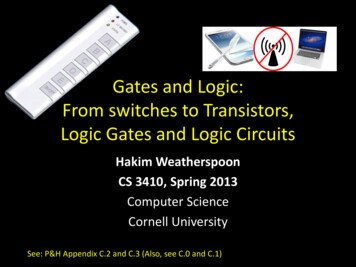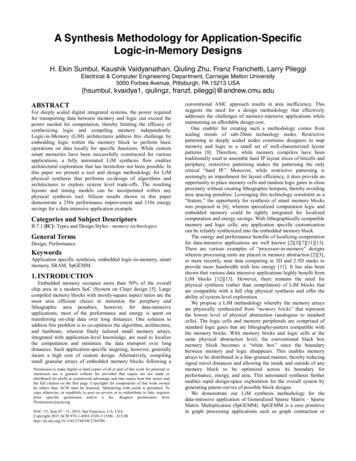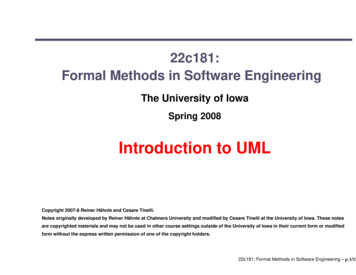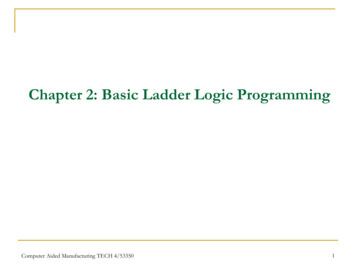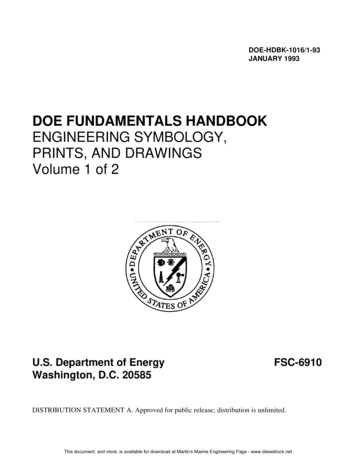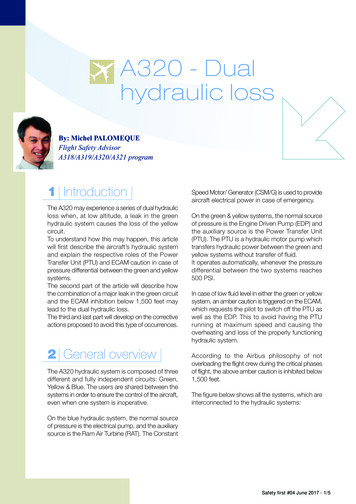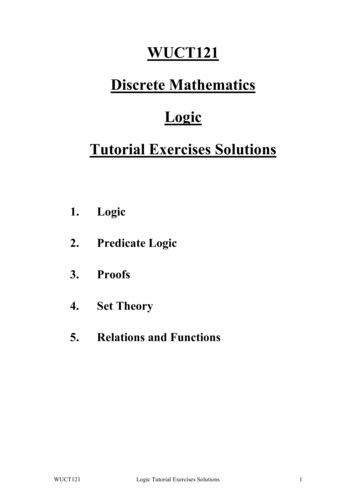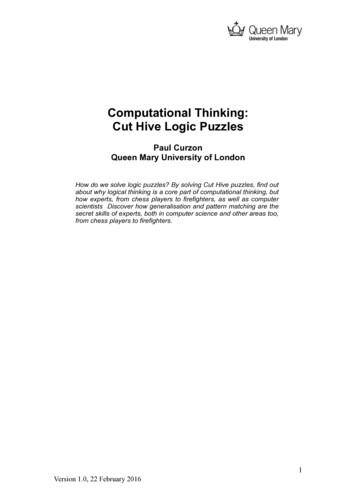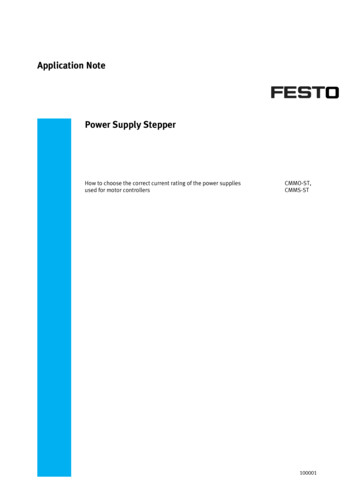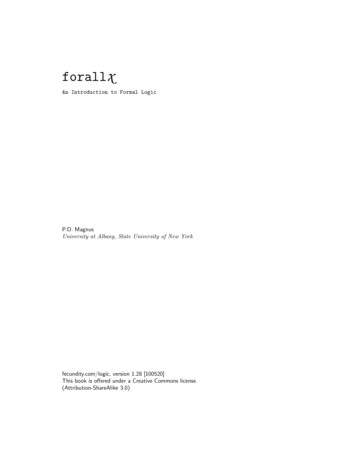
Transcription
forallxAn Introduction to Formal LogicP.D. MagnusUniversity at Albany, State University of New Yorkfecundity.com/logic, version 1.28 [100520]This book is offered under a Creative Commons license.(Attribution-ShareAlike 3.0)
The author would like to thank the people who made this project possible. Notableamong these are Cristyn Magnus, who read many early drafts; Aaron Schiller, whowas an early adopter and provided considerable, helpful feedback; and Bin Kang,Craig Erb, Nathan Carter, Wes McMichael, Selva Samuel, Dave Krueger, BrandonLee, and the students of Introduction to Logic, who detected various errors inprevious versions of the book.c 2005–2010 by P.D. Magnus. Some rights reserved.You are free to copy this book, to distribute it, to display it, and to make derivative works,under the following conditions: (a) Attribution. You must give the original author credit. (b)Share Alike. If you alter, transform, or build upon this work, you may distribute the resultingwork only under a license identical to this one. — For any reuse or distribution, you mustmake clear to others the license terms of this work. Any of these conditions can be waived ifyou get permission from the copyright holder. Your fair use and other rights are in no wayaffected by the above. — This is a human-readable summary of the full license, which isavailable on-line at setting was carried out entirely in LATEX2ε. The style for typesetting proofsis based on fitch.sty (v0.4) by Peter Selinger, University of Ottawa.This copy of forallx is current as of May 20, 2010. The most recent versionis available on-line at http://www.fecundity.com/logic
Contents1 What is logic?1.1 Arguments . . . . . . . . . .1.2 Sentences . . . . . . . . . . .1.3 Two ways that arguments can1.4 Deductive validity . . . . . .1.5 Other logical notions . . . . .1.6 Formal languages . . . . . . .Practice Exercises . . . . . . . . . . . . . . . . . . .go wrong. . . . . . . . . . . . . . . . . . . . .566781012152 Sentential logic2.1 Sentence letters . . .2.2 Connectives . . . . .2.3 Other symbolization2.4 Sentences of SL . . .Practice Exercises . . . .171719282933.3 Truth tables3.1 Truth-functional connectives .3.2 Complete truth tables . . . .3.3 Using truth tables . . . . . .3.4 Partial truth tables . . . . . .Practice Exercises . . . . . . . . .3737384142444 Quantified logic4.1 From sentences to predicates4.2 Building blocks of QL . . . .4.3 Quantifiers . . . . . . . . . .4.4 Translating to QL . . . . . .4.5 Sentences of QL . . . . . . . .4.6 Identity . . . . . . . . . . . .Practice Exercises . . . . . . . . .48485054576871765 Formal semantics835.1 Semantics for SL . . . . . . . . . . . . . . . . . . . . . . . . . . . 843
4CONTENTS5.2 Interpretations and models in QL5.3 Semantics for identity . . . . . .5.4 Working with models . . . . . . .5.5 Truth in QL . . . . . . . . . . . .Practice Exercises . . . . . . . . . . .6 Proofs6.1 Basic rules for SL . . . . . .6.2 Derived rules . . . . . . . .6.3 Rules of replacement . . . .6.4 Rules for quantifiers . . . .6.5 Rules for identity . . . . . .6.6 Proof strategy . . . . . . . .6.7 Proof-theoretic concepts . .6.8 Proofs and models . . . . .6.9 Soundness and completenessPractice Exercises . . . . . . . . 88. 92. 94. 98. 103.107108117119121126128129131132134A Other symbolic notation140B Solutions to selected exercises143C Quick Reference156
Chapter 1What is logic?Logic is the business of evaluating arguments, sorting good ones from bad ones.In everyday language, we sometimes use the word ‘argument’ to refer to belligerent shouting matches. If you and a friend have an argument in this sense,things are not going well between the two of you.In logic, we are not interested in the teeth-gnashing, hair-pulling kind of argument. A logical argument is structured to give someone a reason to believesome conclusion. Here is one such argument:(1) It is raining heavily.(2) If you do not take an umbrella, you will get soaked. . You should take an umbrella.The three dots on the third line of the argument mean ‘Therefore’ and theyindicate that the final sentence is the conclusion of the argument. The othersentences are premises of the argument. If you believe the premises, then theargument provides you with a reason to believe the conclusion.This chapter discusses some basic logical notions that apply to arguments in anatural language like English. It is important to begin with a clear understanding of what arguments are and of what it means for an argument to be valid.Later we will translate arguments from English into a formal language. Wewant formal validity, as defined in the formal language, to have at least some ofthe important features of natural-language validity.5
forallx61.1ArgumentsWhen people mean to give arguments, they typically often use words like ‘therefore’ and ‘because.’ When analyzing an argument, the first thing to do is toseparate the premises from the conclusion. Words like these are a clue to whatthe argument is supposed to be, especially if— in the argument as given— theconclusion comes at the beginning or in the middle of the argument.premise indicators: since, because, given thatconclusion indicators: therefore, hence, thus, then, soTo be perfectly general, we can define an argument as a series of sentences.The sentences at the beginning of the series are premises. The final sentence inthe series is the conclusion. If the premises are true and the argument is a goodone, then you have a reason to accept the conclusion.Notice that this definition is quite general. Consider this example:There is coffee in the coffee pot.There is a dragon playing bassoon on the armoire. . Salvador Dali was a poker player.It may seem odd to call this an argument, but that is because it would bea terrible argument. The two premises have nothing at all to do with theconclusion. Nevertheless, given our definition, it still counts as an argument—albeit a bad one.1.2SentencesIn logic, we are only interested in sentences that can figure as a premise orconclusion of an argument. So we will say that a sentence is something thatcan be true or false.You should not confuse the idea of a sentence that can be true or false withthe difference between fact and opinion. Often, sentences in logic will expressthings that would count as facts— such as ‘Kierkegaard was a hunchback’ or‘Kierkegaard liked almonds.’ They can also express things that you might thinkof as matters of opinion— such as, ‘Almonds are yummy.’Also, there are things that would count as ‘sentences’ in a linguistics or grammarcourse that we will not count as sentences in logic.
ch. 1 what is logic?7Questions In a grammar class, ‘Are you sleepy yet?’ would count as aninterrogative sentence. Although you might be sleepy or you might be alert, thequestion itself is neither true nor false. For this reason, questions will not countas sentences in logic. Suppose you answer the question: ‘I am not sleepy.’ Thisis either true or false, and so it is a sentence in the logical sense. Generally,questions will not count as sentences, but answers will.‘What is this course about?’ is not a sentence. ‘No one knows what this courseis about’ is a sentence.Imperatives Commands are often phrased as imperatives like ‘Wake up!’, ‘Situp straight’, and so on. In a grammar class, these would count as imperativesentences. Although it might be good for you to sit up straight or it might not,the command is neither true nor false. Note, however, that commands are notalways phrased as imperatives. ‘You will respect my authority’ is either trueor false— either you will or you will not— and so it counts as a sentence in thelogical sense.Exclamations ‘Ouch!’ is sometimes called an exclamatory sentence, but itis neither true nor false. We will treat ‘Ouch, I hurt my toe!’ as meaning thesame thing as ‘I hurt my toe.’ The ‘ouch’ does not add anything that could betrue or false.1.3Two ways that arguments can go wrongConsider the argument that you should take an umbrella (on p. 5, above). Ifpremise (1) is false— if it is sunny outside— then the argument gives you noreason to carry an umbrella. Even if it is raining outside, you might not need anumbrella. You might wear a rain pancho or keep to covered walkways. In thesecases, premise (2) would be false, since you could go out without an umbrellaand still avoid getting soaked.Suppose for a moment that both the premises are true. You do not own a rainpancho. You need to go places where there are no covered walkways. Now doesthe argument show you that you should take an umbrella? Not necessarily.Perhaps you enjoy walking in the rain, and you would like to get soaked. Inthat case, even though the premises were true, the conclusion would be false.For any argument, there are two ways that it could be weak. First, one or moreof the premises might be false. An argument gives you a reason to believe itsconclusion only if you believe its premises. Second, the premises might fail to
forallx8support the conclusion. Even if the premises were true, the form of the argumentmight be weak. The example we just considered is weak in both ways.When an argument is weak in the second way, there is something wrong withthe logical form of the argument: Premises of the kind given do not necessarilylead to a conclusion of the kind given. We will be interested primarily in thelogical form of arguments.Consider another example:You are reading this book.This is a logic book. . You are a logic student.This is not a terrible argument. Most people who read this book are logicstudents. Yet, it is possible for someone besides a logic student to read thisbook. If your roommate picked up the book and thumbed through it, they wouldnot immediately become a logic student. So the premises of this argument, eventhough they are true, do not guarantee the truth of the conclusion. Its logicalform is less than perfect.An argument that had no weakness of the second kind would have perfect logicalform. If its premises were true, then its conclusion would necessarily be true.We call such an argument ‘deductively valid’ or just ‘valid.’Even though we might count the argument above as a good argument in somesense, it is not valid; that is, it is ‘invalid.’ One important task of logic is tosort valid arguments from invalid arguments.1.4Deductive validityAn argument is deductively valid if and only if it is impossible for the premisesto be true and the conclusion false.The crucial thing about a valid argument is that it is impossible for the premisesto be true at the same time that the conclusion is false. Consider this example:Oranges are either fruits or musical instruments.Oranges are not fruits. . Oranges are musical instruments.The conclusion of this argument is ridiculous. Nevertheless, it follows validlyfrom the premises. This is a valid argument. If both premises were true, thenthe conclusion would necessarily be true.
ch. 1 what is logic?9This shows that a deductively valid argument does not need to have truepremises or a true conclusion. Conversely, having true premises and a trueconclusion is not enough to make an argument valid. Consider this example:London is in England.Beijing is in China. . Paris is in France.The premises and conclusion of this argument are, as a matter of fact, all true.This is a terrible argument, however, because the premises have nothing to dowith the conclusion. Imagine what would happen if Paris declared independencefrom the rest of France. Then the conclusion would be false, even though thepremises would both still be true. Thus, it is logically possible for the premisesof this argument to be true and the conclusion false. The argument is invalid.The important thing to remember is that validity is not about the actual truthor falsity of the sentences in the argument. Instead, it is about the form ofthe argument: The truth of the premises is incompatible with the falsity of theconclusion.Inductive argumentsThere can be good arguments which nevertheless fail to be deductively valid.Consider this one:In January 1997, it rained in San Diego.In January 1998, it rained in San Diego.In January 1999, it rained in San Diego. . It rains every January in San Diego.This is an inductive argument, because it generalizes from many cases to aconclusion about all cases.Certainly, the argument could be made stronger by adding additional premises:In January 2000, it rained in San Diego. In January 2001. . . and so on. Regardless of how many premises we add, however, the argument will still not bedeductively valid. It is possible, although unlikely, that it will fail to rain nextJanuary in San Diego. Moreover, we know that the weather can be fickle. Noamount of evidence should convince us that it rains there every January. Whois to say that some year will not be a freakish year in which there is no rainin January in San Diego; even a single counter-example is enough to make theconclusion of the argument false.
forallx10Inductive arguments, even good inductive arguments, are not deductively valid.We will not be interested in inductive arguments in this book.1.5Other logical notionsIn addition to deductive validity, we will be interested in some other logicalconcepts.Truth-valuesTrue or false is said to be the truth-value of a sentence. We defined sentencesas things that could be true or false; we could have said instead that sentencesare things that can have truth-values.Logical truthIn considering arguments formally, we care about what would be true if thepremises were true. Generally, we are not concerned with the actual truth valueof any particular sentences— whether they are actually true or false. Yet thereare some sentences that must be true, just as a matter of logic.Consider these sentences:1. It is raining.2. Either it is raining, or it is not.3. It is both raining and not raining.In order to know if sentence 1 is true, you would need to look outside or check theweather channel. Logically speaking, it might be either true or false. Sentenceslike this are called contingent sentences.Sentence 2 is different. You do not need to look outside to know that it is true.Regardless of what the weather is like, it is either raining or not. This sentenceis logically true; it is true merely as a matter of logic, regardless of what theworld is actually like. A logically true sentence is called a tautology.You do not need to check the weather to know about sentence 3, either. It mustbe false, simply as a matter of logic. It might be raining here and not rainingacross town, it might be raining now but stop raining even as you read this, butit is impossible for it to be both raining and not raining here at this moment.
ch. 1 what is logic?11The third sentence is logically false; it is false regardless of what the world islike. A logically false sentence is called a contradiction.To be precise, we can define a contingent sentence as a sentence that isneither a tautology nor a contradiction.A sentence might always be true and still be contingent. For instance, if therenever were a time when the universe contained fewer than seven things, thenthe sentence ‘At least seven things exist’ would always be true. Yet the sentenceis contingent; its truth is not a matter of logic. There is no contradiction inconsidering a possible world in which there are fewer than seven things. Theimportant question is whether the sentence must be true, just on account oflogic.Logical equivalenceWe can also ask about the logical relations between two sentences. For example:John went to the store after he washed the dishes.John washed the dishes before he went to the store.These two sentences are both contingent, since John might not have gone tothe store or washed dishes at all. Yet they must have the same truth-value. Ifeither of the sentences is true, then they both are; if either of the sentences isfalse, then they both are. When two sentences necessarily have the same truthvalue, we say that they are logically equivalent.ConsistencyConsider these two sentences:B1 My only brother is taller than I am.B2 My only brother is shorter than I am.Logic alone cannot tell us which, if either, of these sentences is true. Yet we cansay that if the first sentence (B1) is true, then the second sentence (B2) mustbe false. And if B2 is true, then B1 must be false. It cannot be the case thatboth of these sentences are true.If a set of sentences could not all be true at the same time, like B1–B2, they aresaid to be inconsistent. Otherwise, they are consistent.
forallx12We can ask about the consistency of any number of sentences. For example,consider the following list of sentences:G1G2G3G4ThereThereThereEveryare at least four giraffes at the wild animal park.are exactly seven gorillas at the wild animal park.are not more than two martians at the wild animal park.giraffe at the wild animal park is a martian.G1 and G4 together imply that there are at least four martian giraffes at thepark. This conflicts with G3, which implies that there are no more than twomartian giraffes there. So the set of sentences G1–G4 is inconsistent. Noticethat the inconsistency has nothing at all to do with G2. G2 just happens to bepart of an inconsistent set.Sometimes, people will say that an inconsistent set of sentences ‘contains acontradiction.’ By this, they mean that it would be logically impossible for allof the sentences to be true at once. A set can be inconsistent even when all ofthe sentences in it are either contingent or tautologous. When a single sentenceis a contradiction, then that sentence alone cannot be true.1.6Formal languagesHere is a famous valid argument:Socrates is a man.All men are mortal. . Socrates is mortal.This is an iron-clad argument. The only way you could challenge the conclusionis by denying one of the premises— the logical form is impeccable. What aboutthis next argument?Socrates is a man.All men are carrots. . Socrates is a carrot.This argument might be less interesting than the first, because the secondpremise is obviously false. There is no clear sense in which all men are carrots. Yet the argument is valid. To see this, notice that both arguments havethis form:
ch. 1 what is logic?13S is M .All M s are Cs. . S is C.In both arguments S stands for Socrates and M stands for man. In the firstargument, C stands for mortal; in the second, C stands for carrot. Both arguments have this form, and every argument of this form is valid. So botharguments are valid.What we did here was replace words like ‘man’ or ‘carrot’ with symbols like‘M’ or ‘C’ so as to make the logical form explicit. This is the central ideabehind formal logic. We want to remove irrelevant or distracting features of theargument to make the logical form more perspicuous.Starting with an argument in a natural language like English, we translate theargument into a formal language. Parts of the English sentences are replacedwith letters and symbols. The goal is to reveal the formal structure of theargument, as we did with these two.There are formal languages that work like the symbolization we gave for thesetwo arguments. A logic like this was developed by Aristotle, a philosopher wholived in Greece during the 4th century BC. Aristotle was a student of Plato andthe tutor of Alexander the Great. Aristotle’s logic, with some revisions, was thedominant logic in the western world for more than two millennia.In Aristotelean logic, categories are replaced with capital letters. Every sentenceof an argument is then represented as having one of four forms, which medievallogicians labeled in this way: (A) All As are Bs. (E) No As are Bs. (I) SomeA is B. (O) Some A is not B.It is then possible to describe valid syllogisms, three-line arguments like thetwo we considered above. Medieval logicians gave mnemonic names to all ofthe valid argument forms. The form of our two arguments, for instance, wascalled Barbara. The vowels in the name, all As, represent the fact that the twopremises and the conclusion are all (A) form sentences.There are many limitations to Aristotelean logic. One is that it makes nodistinction between kinds and individuals. So the first premise might just aswell be written ‘All Ss are M s’: All Socrateses are men. Despite its historicalimportance, Aristotelean logic has been superceded. The remainder of this bookwill develop two formal languages.The first is SL, which stands for sentential logic. In SL, the smallest units aresentences themselves. Simple sentences are represented as letters and connectedwith logical connectives like ‘and’ and ‘not’ to make more complex sentences.
forallx14The second is QL, which stands for quantified logic. In QL, the basic units areobjects, properties of objects, and relations between objects.When we translate an argument into a formal language, we hope to make itslogical structure clearer. We want to include enough of the structure of theEnglish language argument so that we can judge whether the argument is validor invalid. If we included every feature of the English language, all of thesubtlety and nuance, then there would be no advantage in translating to aformal language. We might as well think about the argument in English.At the same time, we would like a formal language that allows us to representmany kinds of English language arguments. This is one reason to prefer QL toAristotelean logic; QL can represent every valid argument of Aristotelean logicand more.So when deciding on a formal language, there is inevitably a tension betweenwanting to capture as much structure as possible and wanting a simple formallanguage— simpler formal languages leave out more. This means that there isno perfect formal language. Some will do a better job than others in translatingparticular English-language arguments.In this book, we make the assumption that true and false are the only possibletruth-values. Logical languages that make this assumption are called bivalent,which means two-valued. Aristotelean logic, SL, and QL are all bivalent, butthere are limits to the power of bivalent logic. For instance, some philosophershave claimed that the future is not yet determined. If they are right, thensentences about what will be the case are not yet true or false. Some formallanguages accommodate this by allowing for sentences that are neither true norfalse, but something in between. Other formal languages, so-called paraconsistent logics, allow for sentences that are both true and false.The languages presented in this book are not the only possible formal languages.However, most nonstandard logics extend on the basic formal structure of thebivalent logics discussed in this book. So this is a good place to start.Summary of logical notions. An argument is (deductively) valid if it is impossible for the premises tobe true and the conclusion false; it is invalid otherwise. A tautology is a sentence that must be true, as a matter of logic. A contradiction is a sentence that must be false, as a matter of logic. A contingent sentence is neither a tautology nor a contradiction.
ch. 1 what is logic?15. Two sentences are logically equivalent if they necessarily have thesame truth value. A set of sentences is consistent if it is logically possible for all the members of the set to be true at the same time; it is inconsistent otherwise.Practice ExercisesAt the end of each chapter, you will find a series of practice problems thatreview and explore the material covered in the chapter. There is no substitutefor actually working through some problems, because logic is more about a wayof thinking than it is about memorizing facts. The answers to some of theproblems are provided at the end of the book in appendix B; the problems thatare solved in the appendix are marked with a ?.Part A Which of the following are ‘sentences’ in the logical sense?1.2.3.4.5.6.7.8.9.10.England is smaller than China.Greenland is south of Jerusalem.Is New Jersey east of Wisconsin?The atomic number of helium is 2.The atomic number of helium is π.I hate overcooked noodles.Blech! Overcooked noodles!Overcooked noodles are disgusting.Take your time.This is the last question.Part B For each of the following: Is it a tautology, a contradiction, or a contingent sentence?1.2.3.4.5.Caesar crossed the Rubicon.Someone once crossed the Rubicon.No one has ever crossed the Rubicon.If Caesar crossed the Rubicon, then someone has.Even though Caesar crossed the Rubicon, no one has ever crossed theRubicon.6. If anyone has ever crossed the Rubicon, it was Caesar.? Part C Look back at the sentences G1–G4 on p. 12, and consider each of thefollowing sets of sentences. Which are consistent? Which are inconsistent?
andG4G4G4G3? Part D Which of the following is possible? If it is possible, give an example.If it is not possible, explain why.1.2.3.4.5.6.7.A valid argument that has one false premise and one true premiseA valid argument that has a false conclusionA valid argument, the conclusion of which is a contradictionAn invalid argument, the conclusion of which is a tautologyA tautology that is contingentTwo logically equivalent sentences, both of which are tautologiesTwo logically equivalent sentences, one of which is a tautology and one ofwhich is contingent8. Two logically equivalent sentences that together are an inconsistent set9. A consistent set of sentences that contains a contradiction10. An inconsistent set of sentences that contains a tautology
Chapter 2Sentential logicThis chapter introduces a logical language called SL. It is a version of sententiallogic, because the basic units of the language will represent entire sentences.2.1Sentence lettersIn SL, capital letters are used to represent basic sentences. Considered only as asymbol of SL, the letter A could mean any sentence. So when translating fromEnglish into SL, it is important to provide a symbolization key. The key providesan English language sentence for each sentence letter used in the symbolization.For example, consider this argument:There is an apple on the desk.If there is an apple on the desk, then Jenny made it to class. . Jenny made it to class.This is obviously a valid argument in English. In symbolizing it, we want topreserve the structure of the argument that makes it valid. What happens ifwe replace each sentence with a letter? Our symbolization key would look likethis:A: There is an apple on the desk.B: If there is an apple on the desk, then Jenny made it to class.C: Jenny made it to class.We would then symbolize the argument in this way:17
forallx18AB. . CThere is no necessary connection between some sentence A, which could be anysentence, and some other sentences B and C, which could be any sentences.The structure of the argument has been completely lost in this translation.The important thing about the argument is that the second premise is notmerely any sentence, logically divorced from the other sentences in the argument. The second premise contains the first premise and the conclusion as parts.Our symbolization key for the argument only needs to include meanings for Aand C, and we can build the second premise from those pieces. So we symbolizethe argument this way:AIf A, then C. . CThis preserves the structure of the argument that makes it valid, but it stillmakes use of the English expression ‘If. . . then. . .’ Although we ultimatelywant to replace all of the English expressions with logical notation, this is agood start.The sentences that can be symbolized with sentence letters are called atomicsentences, because they are the basic building blocks out of which more complexsentences can be built. Whatever logical structure a sentence might have is lostwhen it is translated as an atomic sentence. From the point of view of SL, thesentence is just a letter. It can be used to build more complex sentences, but itcannot be taken apart.There are only twenty-six letters of the alphabet, but there is no logical limitto the number of atomic sentences. We can use the same letter to symbolizedifferent atomic sentences by adding a subscript, a small number written afterthe letter. We could have a symbolization key that looks like this:A1 :A2 :A3 :.A294 :The apple is under the armoire.Arguments in SL always contain atomic sentences.Adam Ant is taking an airplane from Anchorage to Albany.Alliteration angers otherwise affable astronauts.Keep in mind that each of these is a different sentence letter. When there aresubscripts in the symbolization key, it is important to keep track of them.
ch. 2 sentential logic2.219ConnectivesLogical connectives are used to build complex sentences from atomic components. There are five logical connectives in SL. This table summarizes them,and they are explained below.symbol & what it is onditionalwhat it means‘It is not the case that. . .’‘Both. . . and . . .’‘Either. . . or . . .’‘If . . . then . . .’‘. . . if and only if . . .’NegationConsider how we might symbolize these sentences:1. Mary is in Barcelona.2. Mary is not in Barcelona.3.
In everyday language, we sometimes use the word ‘argument’ to refer to bel-ligerent shouting matches. If you and a friend have an argument in this sense, things are not going well between the two of you. In logic, we are not interested in th

